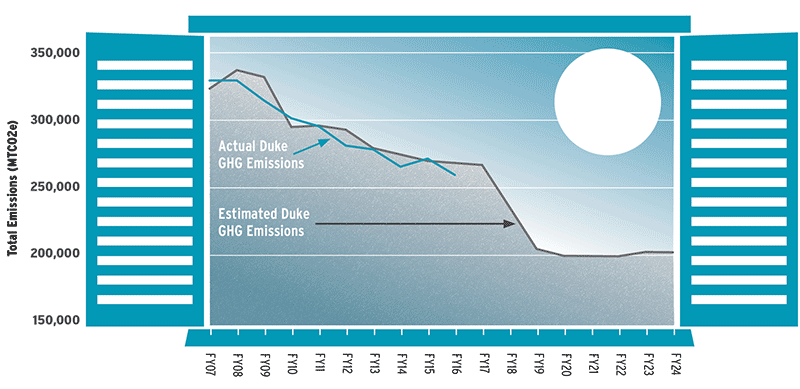Duke remains on track with the Climate Action Plan commitment to become carbon neutral by 2024. The fiscal year 2016 (FY16) greenhouse gas inventory shows a 23% decrease of overall emissions from the 2007 baseline.
Duke's Sustainability Strategic Plan continues to encompass more areas of the campus footprint. This year, the Campus Sustainability Committee focused attention on how Duke's financial decisions from campus procurement to investment can enhance sustainability efforts. Final recommendations around procurement include better utilizing Buy@Duke, Duke's electronic purchasing system, to clearly identify environmentally preferable products (EPP), educate and create incentives for campus consumers about EPP options, and work with stakeholders to develop EPP policies in key areas.
Regarding investment, final recommendations included the desire to create a Duke "Impact Choice" fund, similar to the current Social Choice fund, to actively target low-carbon investments and create opportunities for increased education in the field of sustainable investing at Duke. As a result of this work, students from the Fuqua School of Business will be exploring the development of such a fund during the 2016-17 academic year as part of the CASE i3 Consulting Practicum.
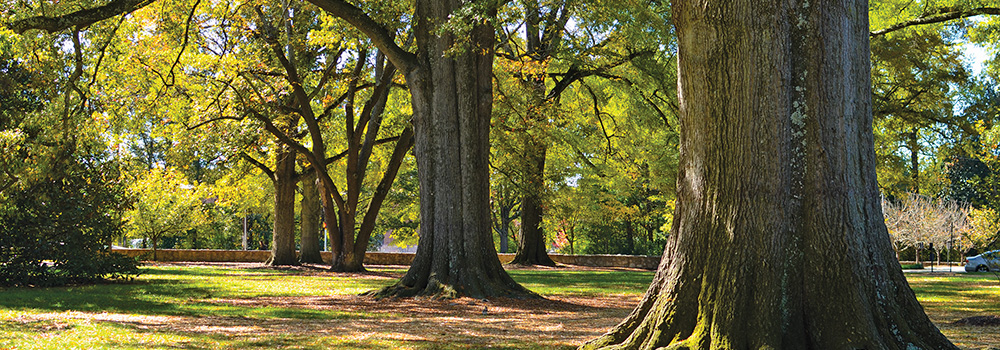

Duke's overall emissions are down 23% from a 2007 baseline. While energy emissions are down 37%, transportation emissions have risen 27%. Despite concerted expansion of alternative transportation options, air travel and employee commuting emissions have proven hard to impact due to the personal nature of these decisions.
Research from the Loyd Ray Farms swine waste-to-energy system, urban forest pilot program, and Bass Connection in Energy campus digester project has led to new offset opportunities. Duke Energy in North Carolina has increased the purchase of swine biogas, partnerships with cities and schools across the nation have led to the planting of more urban trees, and on-campus opportunities for experiential learning have expanded.
In FY16, the Duke Carbon Offsets Initiative worked with national partners to develop new peer reviewed and innovative offsets guidelines to decrease the cost of verification for higher education offset projects and leverage academic research at Duke and other schools to develop new and innovative project types.
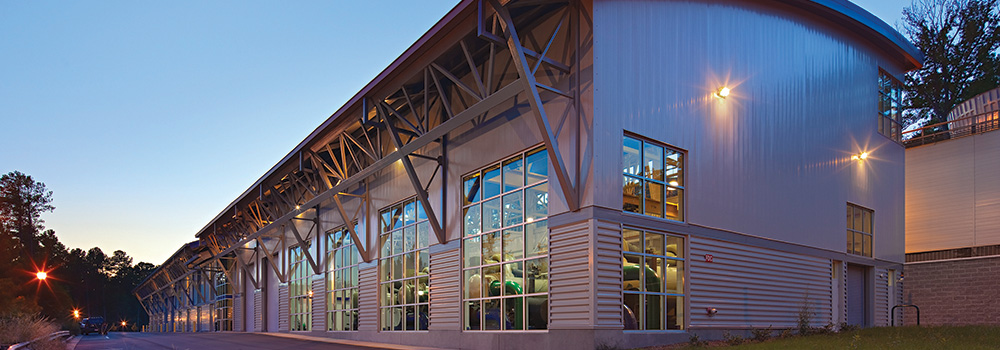
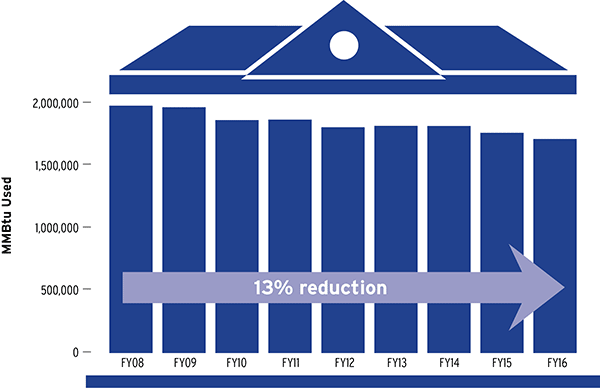
Existing building energy use is down 13%, well ahead of pace to reach the 2030 goal.
Since 2007, building-related energy emissions have decreased 37%. Energy management efforts have saved the University approximately $9.7 million. In FY16, Facilities Management began a comprehensive HVAC re-commissioning effort at the French Family Science Center to improve system performance, improve comfort, and reduce energy use and the carbon footprint in Duke's largest science research facility.
Duke has achieved a 40% reduction in potable water per gross square foot since 2006.
In FY16, Duke began to fully utilize a new Reclamation Pond, saving 90 million gallons of city water in the first year of operation. Facilities Management has also completed the third phase of a multi-year water audit and retrofit project resulting in the installation of low-flow plumbing hardware in the top 30 water consuming University buildings.
As of FY16, Duke has 41 LEED™ certified buildings and 4 buildings registered for certification. This represents 28% of the University's total square footage. Duke has also established a University Green Building Energy Consumption standard to ensure new building projects prioritize utility efficiency.
Duke continues to make progress on a natural resource priorities plan to preserve key areas of campus for education, conservation and aesthetic value. The plan identifies the areas on campus that are preserved as part of designated buffers and areas for future delineation. This plan will inform development on campus to protect important ecological assets while still allowing for future growth.

In 2016, Duke Dining finalized an aspirational sustainability plan to address how and where campus food is grown and raised, processed, transported, prepared and discarded. The plan also highlights the impact these attributes have on health, the environment, society and the economy. It includes targets in food procurement in several major food categories, including produce, meat, and dairy. Duke Dining has furthered sustainable efforts with the Marketplace, the first-year student dining facility on East Campus, recently became certified by the Marine Stewardship Council (MSC), an international non-profit organization established to safeguard seafood supplies and to help create a more sustainable seafood market.
Now in its sixth season, the Duke Campus Farm (DCF) is more accessible than ever, thanks to a new partnership with Uber that allows the Duke community to travel between campus and the farm free of charge. This program helps to meet an increasing demand for academic and co-curricular programming on the farm, including new courses developed by farm staff. In FY16, DCF increased production by 30%, growing close to 4,000 lbs. of sustainable produce with the help of 910 volunteers and an 8-member student farm crew.

Duke has seen fluctuating employee commuting rates over the past several years as external factors such as gas prices and regional transportation options influence these numbers. In FY16, drive alone rates fell to 73% and hopefully will continue to decrease.
Duke has worked to provide alternatives to make cars less necessary on campus, including piloting a campus transportation service with Uber to test new mobility services for students and employees to reach off-campus sites such as the Duke Campus Farm and the Duke Lemur Center. Parking and Transportation Services is also expanding campus infrastructure to encourage fuel efficient vehicles by adding new EV charging stations at key campus locations.
This past year, Duke worked to better utilize Buy@Duke, the electronic purchasing system, to clearly identify environmentally preferable products (EPP) for campus consumers. Currently, 39% of vendors indicate EPP products with three more working on adding this functionality to increase the percentage to 45%. The University also analyzed detailed purchasing data to identify possible areas for EPP policies. These include such products as paper, vehicles, and housekeeping supplies.
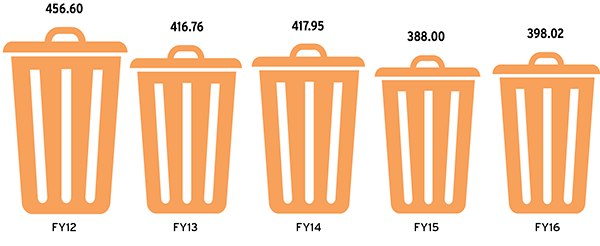
Despite adding an average of 200,000 gross square feet annually and increasing the campus population by more than 2,500 people, the total amount of waste produced on campus has steadily declined since 2012. In FY16, the average person at Duke produced 13% less landfill material compared to a 2012 baseline.
Duke Sanitation and Recycling Services (DSRS), along with its partners in Facilities, Sustainability, and Athletics successfully led Duke Football to have the first waste-free ACC game, diverting 93% of the waste collected at the Duke vs. Pittsburgh game on Nov. 14, 2015. Duke has also expanded waste reduction efforts across campus, diverting 36,744 lbs. (˜18 tons) of material from the landfill via donations from students during spring 2016 move out and working to ensure that all new spaces opened on campus in 2016 incorporated recycling infrastructure.


In fall 2015, Duke approved a new undergraduate experiential certificate in Sustainability Engagement requiring 450 hours of sustainability work outside the classroom along with specific course work. The goal of this program is to provide undergraduates with an opportunity to engage deeply with complex interconnections involved in sustainability-related challenges.
The Trillium Project guides faculty as they explore ways to integrate sustainability into their courses. As of FY16, Trillium has had 116 attendees across 11 institutions. Duke participants have come from 44 unique schools or departments within the University.
In an effort to deepen sustainability knowledge on campus, Duke recently expanded the staff sustainability workshop series to offer specialized sessions on topics including waste reduction, energy, and alternative transportation. As of FY16, there have been 426 attendees in these sustainability trainings.
Students, faculty and staff continue to reduce their environmental impact through the use of engaging tools including Duke's sustainability certifications, including the largest office to date to receive the certification, Duke Health Technology Solutions, who worked diligently to engage over 800 staff members in the certification process. As of FY16, more than 10,000 Duke students, faculty, and staff have participated in these certifications.

In the coming year, Duke's Campus Sustainability Committee will focus attention on an update to the campus Climate Action Plan. This effort will include a review of efforts to date toward carbon neutrality compared to the 2009 proposed strategies, an update to the assumptions that shaped the campus emissions projections, and an assessment of new opportunities.
Several additional projects are expected to be completed over the course of fiscal year 2017:
